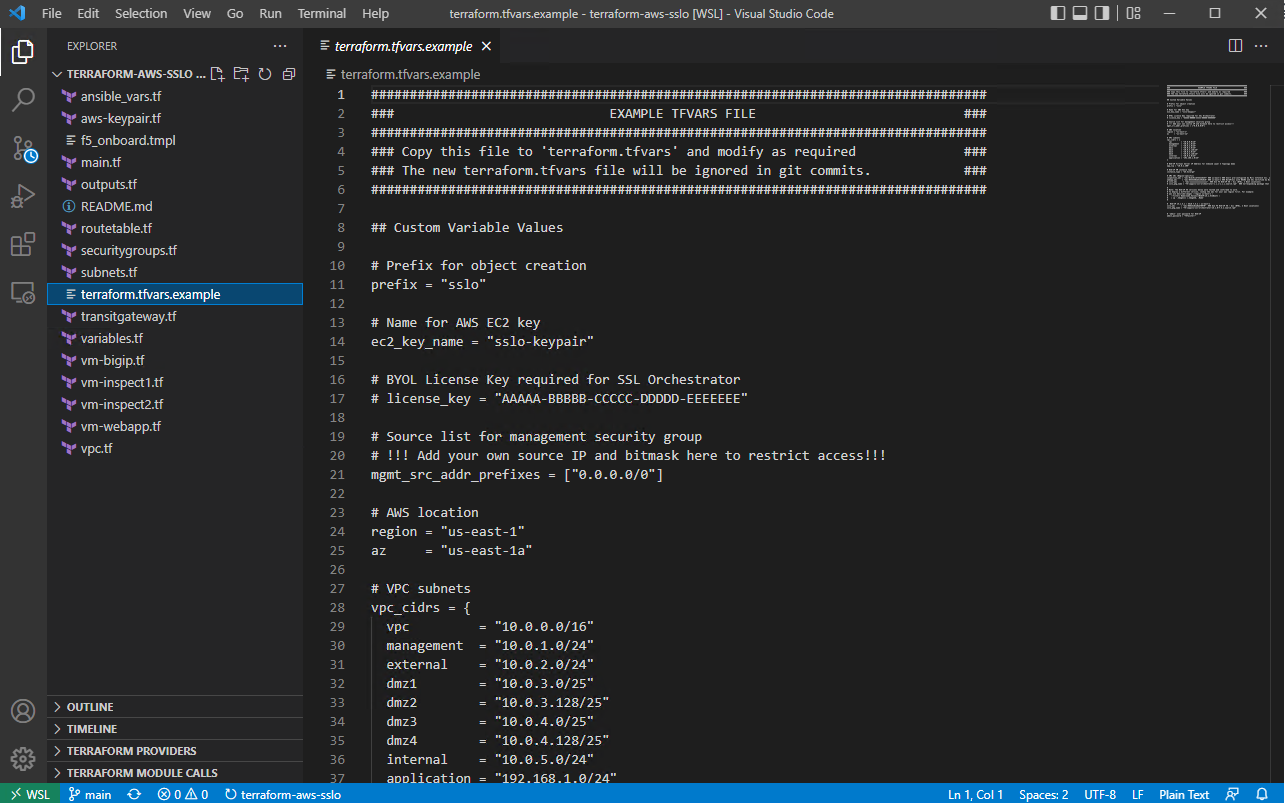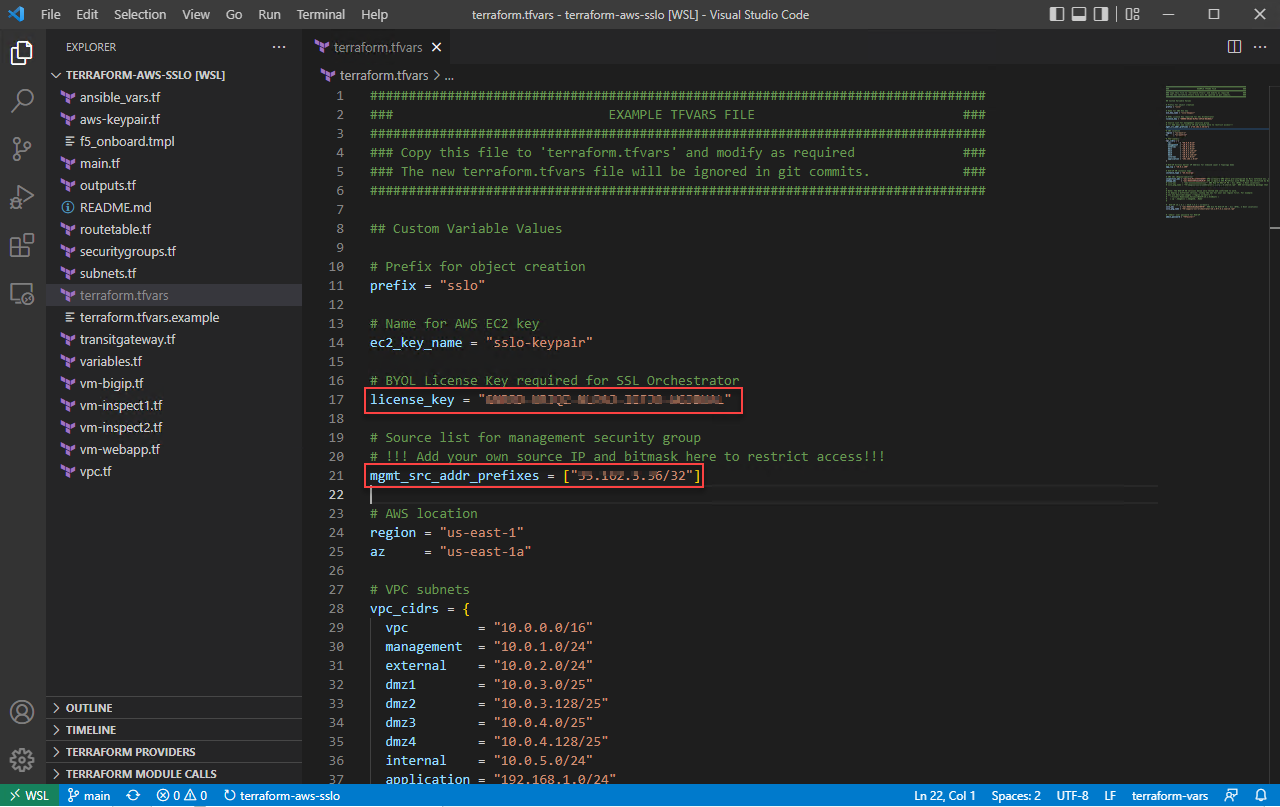F5 BIG-IP SSL Orchestrator Training Lab > All SSL Orchestrator Lab Guides > SSLO 301: Automating SSL Orchestrator Deployments in Public Cloud (Agility 2022 | 2 hours) > 2. Automating BIG-IP (SSL Orchestrator) Provisioning with Terraform Source | Edit on
2.5. Deploy the Terraform Configuration¶
In this section, you will customize the Terraform configuration to deploy the infrastructure in AWS.
The common Terraform deployment steps are as follows:
terraform init
terraform validate
terraform plan
terraform apply -auto-approve
Attention
Before starting this section, please ensure that you have a valid BIG-IP VE license key. Your Agility Labs instructor will provide one to you.
2.5.1. Create a terraform.tfvars File¶
In VSCode, click on the terraform.tfvars.example file. You will use this for the base variable settings of your deployment.
Save it to a new file by selecting File->Save As... from the menu at the top, or by presssing <CTRL-SHIFT-S>. Enter terraform.tfvars as the new filename.
Uncomment the license_key variable and enter the BIG-IP BYOL base registration key that was provided by your instructor.
Add your jump host's public IP address to the remote access ACL. Use a /32 mask.
Note
The IP information was displayed in the BASH terminal when it first launched. You can view it again by launching another BASH terminal or by executing
myip.
Press <CTRL-S> to save the file.
Review the other variables that are defined in this file. The comments describe the purpose of each variable.
Tip
If you prefer to use the VSCode integrated terminal instead of a separate BASH Terminal window, that will also work. Just ensure that you are in the correct directory and execute all commands as if you were using the BASH Terminal window.
To open the integrated terminal, press <CTRL-`> (back-tick) or select View > Terminal from the top menu. You will start in the /home/f5admin directory, so you will have to execute cd ~/sslo-cloud-templates/terraform-aws-sslo again.
2.5.2. Initialize the Terraform¶
Before you can apply a Terraform configuration, you must initialize it. This will download all required Terraform module dependencies.
In your BASH Terminal, execute the following:
terraform init
You should see output similar to the following:
Initializing the backend... Initializing provider plugins... - Finding latest version of hashicorp/template... - Finding hashicorp/aws versions matching "~> 3.0"... - Finding latest version of hashicorp/tls... - Finding latest version of hashicorp/local... - Installing hashicorp/aws v3.75.2... - Installed hashicorp/aws v3.75.2 (signed by HashiCorp) - Installing hashicorp/tls v3.4.0... - Installed hashicorp/tls v3.4.0 (signed by HashiCorp) - Installing hashicorp/local v2.2.3... - Installed hashicorp/local v2.2.3 (signed by HashiCorp) - Installing hashicorp/template v2.2.0... - Installed hashicorp/template v2.2.0 (signed by HashiCorp) Terraform has created a lock file .terraform.lock.hcl to record the provider selections it made above. Include this file in your version control repository so that Terraform can guarantee to make the same selections by default when you run "terraform init" in the future. Terraform has been successfully initialized! You may now begin working with Terraform. Try running "terraform plan" to see any changes that are required for your infrastructure. All Terraform commands should now work. If you ever set or change modules or backend configuration for Terraform, rerun this command to reinitialize your working directory. If you forget, other commands will detect it and remind you to do so if necessary.
Attention
Do not proceed if this process fails. There may be an error in one (or more) of the Terraform configuration files which will require further investigation.
2.5.3. Validate the Terraform¶
Before applying a Terraform configuration, you can validate the configuration files for syntax or consistency errors.
Execute the following:
terraform validate
You should see output similar to the following:
Success! The configuration is valid.
Attention
Do not proceed if this process fails. There may be an error in one (or more) of the Terraform configuration files which will require further investigation.
2.5.4. Review the Terraform Plan¶
Before applying a Terraform configuration, you can review the configuration plan that would be applied. This lists the objects that would be added, changed, and/or destroyed.
Execute the following:
terraform plan
You should see output similar to the following:
<...> Plan: 61 to add, 0 to change, 0 to destroy. Changes to Outputs: + inspection_service_ip_1 = (known after apply) + inspection_service_ip_2 = (known after apply) + sslo_dmz1 = [ + "10.0.3.7", + "10.0.3.8", ] + sslo_dmz2 = [ + "10.0.3.244", + "10.0.3.245", ] + sslo_dmz3 = [ + "10.0.4.7", + "10.0.4.8", ] + sslo_dmz4 = [ + "10.0.4.244", + "10.0.4.245", ] + sslo_external = [ + "10.0.2.11", + "10.0.2.200", ] + sslo_internal = (known after apply) + sslo_management = (known after apply) + sslo_management_public_dns = (known after apply) + sslo_management_public_ip = (known after apply) + sslo_vip = (known after apply) + webapp_internal = (known after apply) ─────────────────────────────────────────────────────────────────────────────────────────────────────────────────────── Note: You didn't use the -out option to save this plan, so Terraform can't guarantee to take exactly these actions if you run "terraform apply" now.
Attention
Do not proceed if this process fails. There may be an error in one (or more) of the Terraform configuration files which will require further investigation.
2.5.5. Apply the Terraform Plan¶
To apply the Terraform configuration, execute the following:
terraform apply -auto-approve
This will take several minutes to complete.
Note
The -auto-approve (or --auto-approve) flag allows you to bypass the approval prompt that would be received before proceeding with the configuration changes.
Attention
If you receive an error similar to the following (for any of the EC2 instances), wait about 5 minutes and then try to apply again. It might require multiple attempts due to timing.
╷ │ Error: Error launching source instance: PendingVerification: Your request │ for accessing resources in this region is being validated, and you will │ not be able to launch additional resources in this region until the │ validation is complete. We will notify you by email once your request has │ been validated. While normally resolved within minutes, please allow up to 4 │ hours for this process to complete. If the issue still persists, please let │ us know by writing to aws-verification@amazon.com for further assistance. │ status code: 400, request id: a3fd2a74-1451-4c8a-a56a-901df30875d4 │ │ with aws_instance.sslo, │ on vm-bigip.tf line 125, in resource "aws_instance" "sslo": │ 125: resource "aws_instance" "sslo" { │ ╵
After successful completion, you should see output similar to the following:
<...> Apply complete! Resources: 2 added, 4 changed, 0 destroyed. Outputs: inspection_service_ip_1 = "10.0.3.21" inspection_service_ip_2 = "10.0.4.21" sslo_dmz1 = toset([ "10.0.3.7", "10.0.3.8", ]) sslo_dmz2 = toset([ "10.0.3.244", "10.0.3.245", ]) sslo_dmz3 = toset([ "10.0.4.7", "10.0.4.8", ]) sslo_dmz4 = toset([ "10.0.4.244", "10.0.4.245", ]) sslo_external = toset([ "10.0.2.11", "10.0.2.200", ]) sslo_internal = "10.0.5.11" sslo_management = "10.0.1.11" sslo_management_public_dns = "ec2-x-x-x-x.compute-1.amazonaws.com" sslo_management_public_ip = "x.x.x.x" sslo_vip = "x.x.x.x" webapp_internal = "192.168.1.200"
2.5.6. Terraform Outputs¶
Take note of the values for the following outputs:
sslo_management_public_ip
sslo_vip
You will need this information later to access the SSL Orchestrator management interface and to test the application.
In the future, if you want to show the Terraform output values again, you can execute the following:
terraform output

